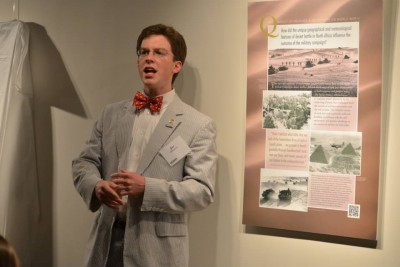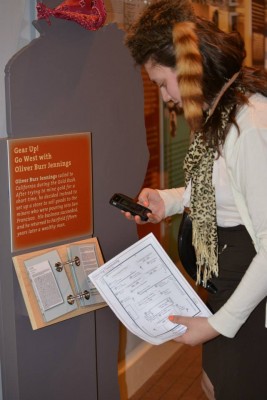
Neag School of Education history education faculty and students are responsible for two innovative exhibits currently on display in two parts of the state: “Behind the Scenes: Museum Footnotes” at the Fairfield Museum and History Center and “Snow, Sand, & Strategy: The Impact of Weather & Geography on WWII” at the Connecticut State Museum of Natural History on UConn’s Storrs campus.
Designed to encourage viewers to explore and critically consider how items are chosen by museums to tell a story, “Behind the Scenes: Museum Footnotes” provides embedded footnotes for 14 of the items featured in the Fairfield Museum’s “Creating Community: Exploring 375 Years of Our Past.” Accessed through a QR code scanned with a smartphone, the footnotes include not just an explanation of how and why the objects were chosen, but a series of interactive questions. For those who don’t have smartphones, paper copies of the footnotes and questions are available.
Neag Associate Professor Alan Marcus, author of “Teaching History with Museums: Strategies for K-12 Social Studies” among other similar works, believes the exhibit represents the first partnership of its kind between museum staff and educators in the U.S.
“One of the many important skills we need to teach students is how to evaluate sources and the trustworthiness of the information they’re receiving,” said Marcus, who spearheaded the project with Fairfield Museum Education Director Christine Jewell. “Like historic films, museum exhibits provide a view into the past, but we need to remember that when we view these works, we’re seeing not ‘the’ view of the past, but ‘a’ view of the past. Like moviemakers make decisions on how to best to bring historic events like slavery and the Civil War to life on the screen, museum curators make decisions about what items to include, what items to put up front and highlight, and what items to not include at all.”
The Museum Footnotes project makes this process transparent, Marcus continued, encouraging students, especially, to consider how curators constructed the past they’re viewing. The interactive questions also encourage and allow students to take a more active role in their learning.
Data captured will allow Marcus and the Neag students who’ve been working with him on this project to examine—and, ideally, better understand—how students used their smartphones as part of the learning process. These Neag students include Department of Educational Psychology doctoral student Jennifer Kowitt and master’s student Michael Stroneski, who’s training to teach social studies.
An addition benefit is that teachers who bring classes to visit can receive a follow-up email from the museum that shows students’ responses to the smartphone questions.

Having students use their phones as part of the school day requires, in most school systems, advance parent permission slips and instructions on how to download free QR code scanning apps. But the potential results, Marcus believes, is well worth the effort.
“Kids love their phones, so why not use them as part of learning, when they can be used so effectively?” Marcus said. “Smartphones use will allow us to capture students’ real-time reactions to what they’re taking in. Teachers can then use that collected data have rich follow-up conversations in the classroom.”
Jewell continued:”This kind of critical thinking and inquiry is at the heart of common core standards and makes this exhibit a real learning opportunity. The footnotes provide an important, added dimension, showing how finances, politics, societal pressure, personal preference and other factors influenced the final product. They show that an educational exhibit may not necessarily be an objective one.”
Marcus said he hopes the success of the Neag-Fairfield Museum partnership will encourage similar collaborations.
“Snow, Sand & Strategy: The Impact of Weather & Geography on WWII” also includes footnotes.
Created by students in the Neag School’s history teacher education program in collaboration with staff from the Connecticut State Museum of Natural History, the exhibit explores the role weather and geography played in World War II military strategy and battle outcomes, as well as how it impacted civilians. Military leaders worked hard not just to limit the challenges geography and weather caused, but to take advantage of them.
“The exhibition is the culmination of three years of effort by the students to explore WWII from multiple perspectives and to study museum education,” said Marcus, who served as faculty advisor for the project. “The students visited WWII sites and museums in Europe, participated in workshops with the United States Holocaust Memorial Museum, and took related coursework. This exhibit is an expression of their growth and development as historians and teachers.”
Divided into seven display panels, each section is anchored by a guiding question detailing a specific aspect of the war. Students worked with museum staff member Collin Harty, who oversees exhibit and communication design. “Collaboration with Connecticut State Museum of Natural History staff provided a wonderful learning experience for the students,” Marcus added. “They received hands-on training that enhanced their understanding of how museum staff create exhibitions and helped them think about how to use, and collaborate with, museums in their future roles as history teachers.”
The Connecticut Museum of Natural History also helped fund the Fairfield “Behind the Scenes: Museum Footnotes” project.
“We’re hoping that one of the results of these efforts is that they change the way people approach museums and make them part of their curriculums,” Marcus said.
For more information about “Snow, Sand, & Strategy: The Impact of Weather & Geography on WWII,” visit http://ww2weathergeography.weebly.com or call (860) 486-4460. The Connecticut State Museum of Natural History is open Monday through Friday from 10 am to 4 pm.
For more information about “Behind the Scenes: Museum Footnotes” and “Creating Community: Exploring 375 Years of Our Past,” visit http://www.fairfieldhistory.org or call (203) 259-1598. The Fairfield Museum and History Center is open daily from 10 am to 4 pm.
 Facebook
Facebook
 Twitter
Twitter
 LinkedIn
LinkedIn
